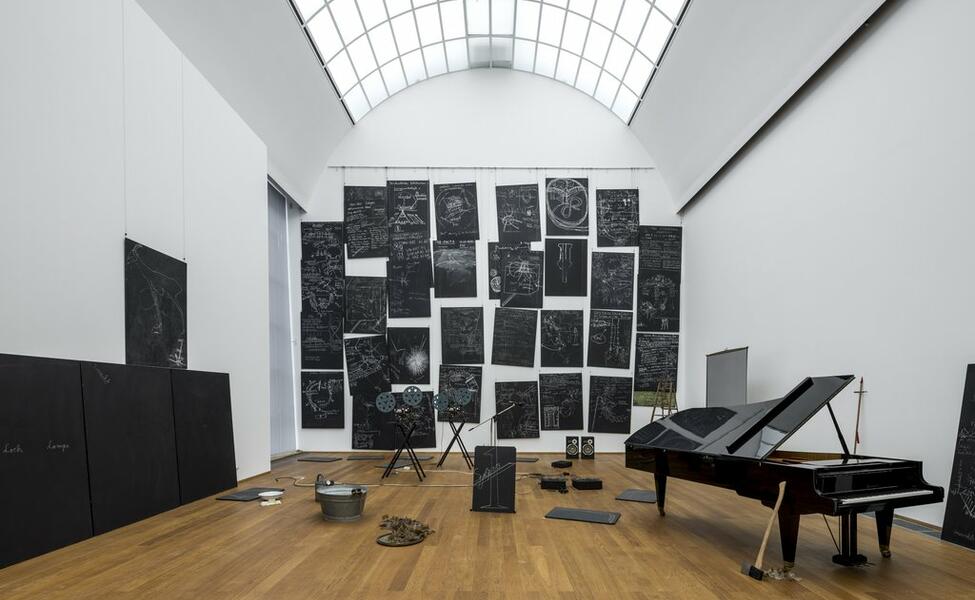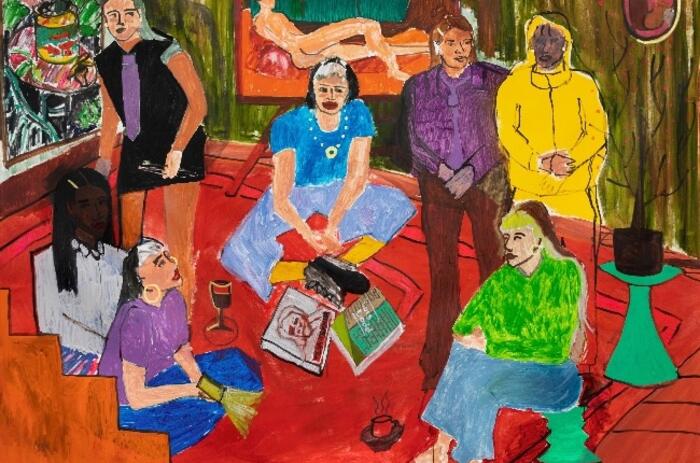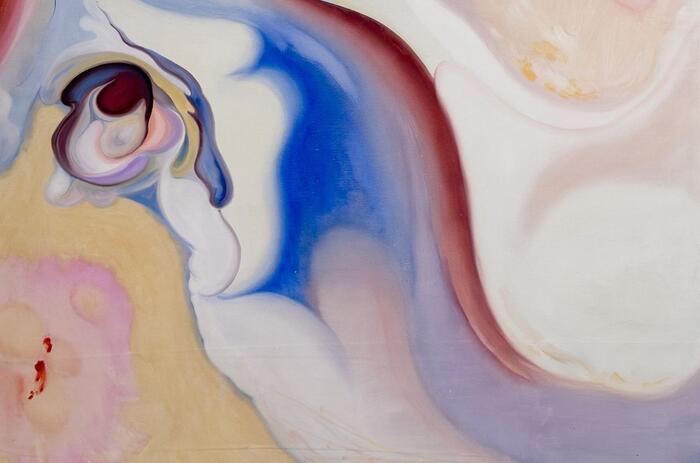JOSEPH BEUYS IN BERLIN: NATURE, MATERIALITY AND LANGUAGE
The Hamburger Bahnhof is presenting its extensive holdings of works by the artist Joseph Beuys (1921–86) in the Kleihueshalle.

Comprising 15 key works by Joseph Beuys, the new presentation in the Kleihueshalle explores the artist’s complex oeuvre and critical reception. Alongside his environment DAS KAPITAL RAUM 1970–1977 (1980), the parcours includes sculptures, drawings, multiples and ground-breaking actions such as I like America and America likes Me (1974). The exhibition examines the ways in which Beuys’s work questioned the nature, materiality, language and perception of the boundaries and tasks of art. At the same time, it contextualizes and compares Beuys’ vision of a slow social transformation with historic and contemporary countermodels by Grace Lee Boggs, Angela Davis, Agnes Denes, Donna Haraway among others.
The exhibition is curated by Catherine Nichols, curator and researcher at Hamburger Bahnhof – Nationalgalerie der Gegenwart.
-
Ausstellungsansicht „Joseph Beuys. Werke aus der Sammlung der Nationalgalerie“, Hamburger Bahnhof – Nationalgalerie der Gegenwart, ab 12. April 2024 / abgebildet: Joseph Beuys, Das Kapital Raum 1970–1977 (Detail, 1980), Holztafeln mit Kreide beschriftet, 50-teilig, Zinkwanne mit Wasser, Seife, Handtücher, Gelatine, elektronische Abspielgeräte und Kabel, Holzlatten, Speer, Axt, Messer, Kieselsteine, Konzertflügel, Taschenlampen, Projektionsleinwand, Maße variabel, Staatliche Museen zu Berlin, Nationalgalerie, Sammlung Marx (Eigentum der Stiftung Preußischer Kulturbesitz), Foto: Jacopo La Forgia
© VG Bild-Kunst, Bonn 2024
-
Ausstellungsansicht „Joseph Beuys. Werke aus der Sammlung der Nationalgalerie“, Hamburger Bahnhof – Nationalgalerie der Gegenwart, ab 12. April 2024 / abgebildet: Joseph Beuys, Das Kapital Raum 1970–1977 (Detail, 1980), Holztafeln mit Kreide beschriftet, 50-teilig, Zinkwanne mit Wasser, Seife, Handtücher, Gelatine, elektronische Abspielgeräte und Kabel, Holzlatten, Speer, Axt, Messer, Kieselsteine, Konzertflügel, Taschenlampen, Projektionsleinwand, Maße variabel, Staatliche Museen zu Berlin, Nationalgalerie, Sammlung Marx (Eigentum der Stiftung Preußischer Kulturbesitz), Foto: Jacopo La Forgia
© VG Bild-Kunst, Bonn 2024
-
Ausstellungsansicht „Joseph Beuys. Werke aus der Sammlung der Nationalgalerie“, Hamburger Bahnhof – Nationalgalerie der Gegenwart, ab 12. April 2024 / abgebildet: Joseph Beuys, Das Kapital Raum 1970–1977 (1980), Holztafeln mit Kreide beschriftet, 50-teilig, Zinkwanne mit Wasser, Seife, Handtücher, Gelatine, elektronische Abspielgeräte und Kabel, Holzlatten, Speer, Axt, Messer, Kieselsteine, Konzertflügel, Taschenlampen, Projektionsleinwand, Maße variabel, Staatliche Museen zu Berlin, Nationalgalerie, Sammlung Marx (Eigentum der Stiftung Preußischer Kulturbesitz), Foto: Jacopo La Forgia
© VG Bild-Kunst, Bonn 2024
-
Ausstellungsansicht „Joseph Beuys. Werke aus der Sammlung der Nationalgalerie“, Hamburger Bahnhof – Nationalgalerie der Gegenwart, ab 12. April 2024 © VG Bild-Kunst Bonn, 2024 / Nationalgalerie – Staatliche Museen zu Berlin / Jacopo La Forgia
-
Joseph Beuys, Das Schweigen, 1973, fünf Filmspulen des gleichnamigen Films von Ingmar Berlgman (1963), verzinkt, Filmspulen je 4 cm x ø 38 cm Auflage: 50 + 10 a.p., Edition René Block, Berlin, und Multiples, New York, Staatliche Museen zu Berlin, Nationalgalerie, 2011 erworben aus Mitteln der Stiftung Renée Sintenis, Foto: Mathias Völzke
VG Bild-Kunst, Bonn 2024
-
Ausstellungsansicht „Joseph Beuys. Werke aus der Sammlung der Nationalgalerie“, Hamburger Bahnhof – Nationalgalerie der Gegenwart, ab 12. April 2024 © VG Bild-Kunst Bonn, 2024 / Nationalgalerie – Staatliche Museen zu Berlin / Jacopo La Forgia
-
Joseph Beuys, Capri-Batterie, 1985, Glühlampe mit Steckerfassung, Zitrone, 8 x 11 x 6 cm, Auflage: 200 + einige a.p., Edizioni Lucio Amelio, Neapel, Staatliche Museen zu Berlin, Nationalgalerie, 2009 erworben durch die Stiftung des Vereins der Freunde der Nationalgalerie für zeitgenössische Kunst, Foto: Roman März
VG Bild-Kunst, Bonn 2024
Joseph Beuys (1921–1986) was a draftsman, sculptor, action and installation artist, teacher, politician and activist. Having grown up under National Socialism in Germany, and actively participated in the Hitler Youth and the armed forces, Beuys sought to transform the totalitarian society of his youth into one of warmth and radical democracy: by means of art, and in conversation and cooperation with all people. Beuys called the collective transformation of society he envisaged “social sculpture.” By that he meant an expanded form of art, in which all human beings – as the artists they innately are – could and should participate. Comprising 15 works, the collection presentation brings together for the first time in one space Tram Stop. A monument to the future (1976), DAS KAPITAL RAUM, 1970–1977 (1980) and THE END OF THE 20TH CENTURY (1982) from the Nationalgalerie Collection. The study island offers visitors an insight into the ambivalent perception of the artist through audio contributions by well-known personalities and selected books and confronts his vision of social renewal with the civil rights activist Angela Davis, the writer Ursula Le Guin or the poet Kae Tempest, among others.
Related Topics
May interest you

Álbum de Casi Todos (Album of Almost Everyone) is the solo exhibition of Chilean artist Pablo Linsambarth at the Instituto Cultural Peruano Norteamericano (ICPNA). It is curated by Daniel H. Rey.
THE STORIES OF PABLO LINSAMBARTH AT ICPNA
Álbum de Casi Todos (Album of Almost Everyone) is the solo exhibition of Chilean artist Pablo Linsambarth at the Instituto Cultural Peruano Norteamericano (ICPNA). It is curated by Daniel H. Rey.

Álbum de Casi Todos (Album of Almost Everyone) is the solo exhibition of Chilean artist Pablo Linsambarth at the Instituto Cultural Peruano Norteamericano (ICPNA). It is curated by Daniel H. Rey.
THE STORIES OF PABLO LINSAMBARTH AT ICPNA
Álbum de Casi Todos (Album of Almost Everyone) is the solo exhibition of Chilean artist Pablo Linsambarth at the Instituto Cultural Peruano Norteamericano (ICPNA). It is curated by Daniel H. Rey.

Juana Subercaseaux, a Chilean artist based in Mexico City, presents Esto es Eso, her first exhibition at OMR, showcasing her latest works that intertwine a feminine perspective with the intimate, the mystical, the ephemeral, and the spiritual aspects of nature.

La Chola Poblete, Argentine artist and LGBTQ+ rights activist, draws confrontation between historical stereotypes and contemporary visual languages. Her colourful works in diverse media disrupt prevailing power structures and celebrate the rich culture of South American Indigenous peoples. Titled after her hometown, Guaymallén is La Chola’s solo exhibition at PalaisPopulaire, curated by Britta Färber, head of Deutsche Bank’s international art and culture program.
LA CHOLA POBLETE EXHIBITS VIRGINS, COLONIALISM AND EROTICA IN GUAYMALLÉN
La Chola Poblete, Argentine artist and LGBTQ+ rights activist, draws confrontation between historical stereotypes and contemporary visual languages. Her colourful works in diverse media disrupt prevailing power structures and celebrate the rich culture of South American Indigenous peoples. Titled after her hometown, Guaymallén is La Chola’s solo exhibition at PalaisPopulaire, curated by Britta Färber, head of Deutsche Bank’s international art and culture program.

The Fundação Biennale de São Paulo announced that Bonaventure Soh Bejeng Ndikung will be the chief curator of the 36th São Paulo Biennale, to be held during the second half of 2025.
BONAVENTURE SOH BEJENG NDIKUNG WILL BE THE CHIEF CURATOR OF THE 36TH SÃO PAULO BIENNALE
The Fundação Biennale de São Paulo announced that Bonaventure Soh Bejeng Ndikung will be the chief curator of the 36th São Paulo Biennale, to be held during the second half of 2025.

Álbum de Casi Todos (Album of Almost Everyone) is the solo exhibition of Chilean artist Pablo Linsambarth at the Instituto Cultural Peruano Norteamericano (ICPNA). It is curated by Daniel H. Rey.
THE STORIES OF PABLO LINSAMBARTH AT ICPNA
Álbum de Casi Todos (Album of Almost Everyone) is the solo exhibition of Chilean artist Pablo Linsambarth at the Instituto Cultural Peruano Norteamericano (ICPNA). It is curated by Daniel H. Rey.

Juana Subercaseaux, a Chilean artist based in Mexico City, presents Esto es Eso, her first exhibition at OMR, showcasing her latest works that intertwine a feminine perspective with the intimate, the mystical, the ephemeral, and the spiritual aspects of nature.

La Chola Poblete, Argentine artist and LGBTQ+ rights activist, draws confrontation between historical stereotypes and contemporary visual languages. Her colourful works in diverse media disrupt prevailing power structures and celebrate the rich culture of South American Indigenous peoples. Titled after her hometown, Guaymallén is La Chola’s solo exhibition at PalaisPopulaire, curated by Britta Färber, head of Deutsche Bank’s international art and culture program.
LA CHOLA POBLETE EXHIBITS VIRGINS, COLONIALISM AND EROTICA IN GUAYMALLÉN
La Chola Poblete, Argentine artist and LGBTQ+ rights activist, draws confrontation between historical stereotypes and contemporary visual languages. Her colourful works in diverse media disrupt prevailing power structures and celebrate the rich culture of South American Indigenous peoples. Titled after her hometown, Guaymallén is La Chola’s solo exhibition at PalaisPopulaire, curated by Britta Färber, head of Deutsche Bank’s international art and culture program.

The Fundação Biennale de São Paulo announced that Bonaventure Soh Bejeng Ndikung will be the chief curator of the 36th São Paulo Biennale, to be held during the second half of 2025.
BONAVENTURE SOH BEJENG NDIKUNG WILL BE THE CHIEF CURATOR OF THE 36TH SÃO PAULO BIENNALE
The Fundação Biennale de São Paulo announced that Bonaventure Soh Bejeng Ndikung will be the chief curator of the 36th São Paulo Biennale, to be held during the second half of 2025.

Álbum de Casi Todos (Album of Almost Everyone) is the solo exhibition of Chilean artist Pablo Linsambarth at the Instituto Cultural Peruano Norteamericano (ICPNA). It is curated by Daniel H. Rey.
THE STORIES OF PABLO LINSAMBARTH AT ICPNA
Álbum de Casi Todos (Album of Almost Everyone) is the solo exhibition of Chilean artist Pablo Linsambarth at the Instituto Cultural Peruano Norteamericano (ICPNA). It is curated by Daniel H. Rey.

Juana Subercaseaux, a Chilean artist based in Mexico City, presents Esto es Eso, her first exhibition at OMR, showcasing her latest works that intertwine a feminine perspective with the intimate, the mystical, the ephemeral, and the spiritual aspects of nature.

La Chola Poblete, Argentine artist and LGBTQ+ rights activist, draws confrontation between historical stereotypes and contemporary visual languages. Her colourful works in diverse media disrupt prevailing power structures and celebrate the rich culture of South American Indigenous peoples. Titled after her hometown, Guaymallén is La Chola’s solo exhibition at PalaisPopulaire, curated by Britta Färber, head of Deutsche Bank’s international art and culture program.
LA CHOLA POBLETE EXHIBITS VIRGINS, COLONIALISM AND EROTICA IN GUAYMALLÉN
La Chola Poblete, Argentine artist and LGBTQ+ rights activist, draws confrontation between historical stereotypes and contemporary visual languages. Her colourful works in diverse media disrupt prevailing power structures and celebrate the rich culture of South American Indigenous peoples. Titled after her hometown, Guaymallén is La Chola’s solo exhibition at PalaisPopulaire, curated by Britta Färber, head of Deutsche Bank’s international art and culture program.

The Fundação Biennale de São Paulo announced that Bonaventure Soh Bejeng Ndikung will be the chief curator of the 36th São Paulo Biennale, to be held during the second half of 2025.
BONAVENTURE SOH BEJENG NDIKUNG WILL BE THE CHIEF CURATOR OF THE 36TH SÃO PAULO BIENNALE
The Fundação Biennale de São Paulo announced that Bonaventure Soh Bejeng Ndikung will be the chief curator of the 36th São Paulo Biennale, to be held during the second half of 2025.

Álbum de Casi Todos (Album of Almost Everyone) is the solo exhibition of Chilean artist Pablo Linsambarth at the Instituto Cultural Peruano Norteamericano (ICPNA). It is curated by Daniel H. Rey.
THE STORIES OF PABLO LINSAMBARTH AT ICPNA
Álbum de Casi Todos (Album of Almost Everyone) is the solo exhibition of Chilean artist Pablo Linsambarth at the Instituto Cultural Peruano Norteamericano (ICPNA). It is curated by Daniel H. Rey.

Juana Subercaseaux, a Chilean artist based in Mexico City, presents Esto es Eso, her first exhibition at OMR, showcasing her latest works that intertwine a feminine perspective with the intimate, the mystical, the ephemeral, and the spiritual aspects of nature.

La Chola Poblete, Argentine artist and LGBTQ+ rights activist, draws confrontation between historical stereotypes and contemporary visual languages. Her colourful works in diverse media disrupt prevailing power structures and celebrate the rich culture of South American Indigenous peoples. Titled after her hometown, Guaymallén is La Chola’s solo exhibition at PalaisPopulaire, curated by Britta Färber, head of Deutsche Bank’s international art and culture program.
LA CHOLA POBLETE EXHIBITS VIRGINS, COLONIALISM AND EROTICA IN GUAYMALLÉN
La Chola Poblete, Argentine artist and LGBTQ+ rights activist, draws confrontation between historical stereotypes and contemporary visual languages. Her colourful works in diverse media disrupt prevailing power structures and celebrate the rich culture of South American Indigenous peoples. Titled after her hometown, Guaymallén is La Chola’s solo exhibition at PalaisPopulaire, curated by Britta Färber, head of Deutsche Bank’s international art and culture program.

The Fundação Biennale de São Paulo announced that Bonaventure Soh Bejeng Ndikung will be the chief curator of the 36th São Paulo Biennale, to be held during the second half of 2025.
BONAVENTURE SOH BEJENG NDIKUNG WILL BE THE CHIEF CURATOR OF THE 36TH SÃO PAULO BIENNALE
The Fundação Biennale de São Paulo announced that Bonaventure Soh Bejeng Ndikung will be the chief curator of the 36th São Paulo Biennale, to be held during the second half of 2025.

Álbum de Casi Todos (Album of Almost Everyone) is the solo exhibition of Chilean artist Pablo Linsambarth at the Instituto Cultural Peruano Norteamericano (ICPNA). It is curated by Daniel H. Rey.
THE STORIES OF PABLO LINSAMBARTH AT ICPNA
Álbum de Casi Todos (Album of Almost Everyone) is the solo exhibition of Chilean artist Pablo Linsambarth at the Instituto Cultural Peruano Norteamericano (ICPNA). It is curated by Daniel H. Rey.

Juana Subercaseaux, a Chilean artist based in Mexico City, presents Esto es Eso, her first exhibition at OMR, showcasing her latest works that intertwine a feminine perspective with the intimate, the mystical, the ephemeral, and the spiritual aspects of nature.

La Chola Poblete, Argentine artist and LGBTQ+ rights activist, draws confrontation between historical stereotypes and contemporary visual languages. Her colourful works in diverse media disrupt prevailing power structures and celebrate the rich culture of South American Indigenous peoples. Titled after her hometown, Guaymallén is La Chola’s solo exhibition at PalaisPopulaire, curated by Britta Färber, head of Deutsche Bank’s international art and culture program.
LA CHOLA POBLETE EXHIBITS VIRGINS, COLONIALISM AND EROTICA IN GUAYMALLÉN
La Chola Poblete, Argentine artist and LGBTQ+ rights activist, draws confrontation between historical stereotypes and contemporary visual languages. Her colourful works in diverse media disrupt prevailing power structures and celebrate the rich culture of South American Indigenous peoples. Titled after her hometown, Guaymallén is La Chola’s solo exhibition at PalaisPopulaire, curated by Britta Färber, head of Deutsche Bank’s international art and culture program.

The Fundação Biennale de São Paulo announced that Bonaventure Soh Bejeng Ndikung will be the chief curator of the 36th São Paulo Biennale, to be held during the second half of 2025.
BONAVENTURE SOH BEJENG NDIKUNG WILL BE THE CHIEF CURATOR OF THE 36TH SÃO PAULO BIENNALE
The Fundação Biennale de São Paulo announced that Bonaventure Soh Bejeng Ndikung will be the chief curator of the 36th São Paulo Biennale, to be held during the second half of 2025.




